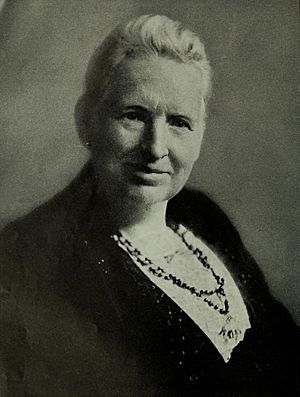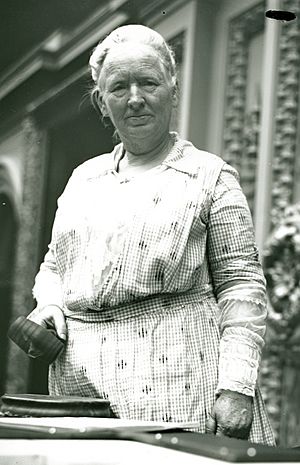Alice Mary Robertson facts for kids
Quick facts for kids
Alice Mary Robertson
|
|
|---|---|
 |
|
| Member of the U.S. House of Representatives from Oklahoma's 2nd district |
|
| In office March 4, 1921 – March 3, 1923 |
|
| Preceded by | William W. Hastings |
| Succeeded by | William W. Hastings |
| Personal details | |
| Born | January 2, 1854 Tullahassee Mission, Muscogee Nation, Indian Territory |
| Died | July 1, 1931 (aged 77) Muskogee, Oklahoma |
| Political party | Republican |
| Alma mater | Elmira College |
| Profession | Educator, public servant |
Alice Mary Robertson (born January 2, 1854 – died July 1, 1931) was an American teacher, social worker, and politician. She was very active in supporting Native American rights. Alice Robertson made history by becoming the second woman ever to serve in the United States Congress. She was also the first woman from Oklahoma to be elected to Congress.
A cool fact about her is that she was the first woman to win an election against a congressman who was already in office. She was known for being a strong person who cared a lot about Native American issues. She also had some unique views, like not supporting some feminist ideas of her time.
Until 2006, Alice Robertson was the only woman from Oklahoma elected to Congress.
Contents
Early Life and Education
Alice Robertson was born in 1854 at the Tullahassee Mission. This was in the Creek Nation, a part of what was then called Indian Territory. Her parents, Ann Eliza and William Schenck Robertson, were missionaries. Missionaries are people who travel to teach about their religion.
Alice's grandfather, Samuel Worcester, was also a missionary who worked with the Cherokee people for a long time. Her parents were very skilled. They translated many important books, including the Bible, into the Creek language.
Alice learned a lot from her parents at home when she was young. Later, she went to Elmira College in Elmira, New York.
Career and Public Service

After college, Alice Robertson started working as a clerk for the Bureau of Indian Affairs (BIA) in Washington, D.C.. This was from 1873 to 1879. The BIA is a government agency that works with Native American tribes.
She then returned to Indian Territory and taught at the Tullahassee school for a short time. From 1880 to 1882, she taught at the Carlisle Indian Industrial School in Carlisle, Pennsylvania. This school was a model for many other Indian boarding schools across the country.
Alice Robertson later came back to Indian Territory and started the Nuyaka Mission. This mission was run by Presbyterians and helped the Creek Council. She also taught in Okmulgee, Oklahoma. There, she was in charge of a Presbyterian boarding school for Native American girls. This school eventually grew into Henry Kendall College, which later became the University of Tulsa.
From 1900 to 1905, Alice Robertson was the first government supervisor for Creek Indian schools. She was chosen for this role by the BIA. Then, President Theodore Roosevelt appointed her as the postmaster of Muskogee, Oklahoma. She served in this role from 1905 to 1913. She was the first woman in the country to be in charge of a major post office.
During World War I, she helped soldiers by providing canteen services. This was the beginning of the American Red Cross chapter in Muskogee.
Serving in Congress
Alice Robertson became more involved in politics. In 1920, she was elected as a Republican Representative for Oklahoma's 2nd District. She won against the person who was already in office, William Hastings. This was a big deal because she was the first woman to defeat a sitting congressman in a general election!
She served in Congress from March 4, 1921, to March 3, 1923. However, she lost her bid for reelection in 1922 to William Hastings.
Alice Robertson was the second woman to ever serve in Congress. The first was Representative Jeannette Rankin from Montana, who served from 1917 to 1919. During her time in Congress, Alice Robertson made history again on June 20, 1921. She became the first woman to lead a meeting in the House of Representatives.
She was also the first woman elected to Congress after the 19th Amendment was passed. This amendment gave women the right to vote. Interestingly, she did not support some feminist groups like the League of Women Voters. She voted against government funding for maternity and childcare programs. She believed these were private matters and the government should not interfere. Because of this, she gained support from groups like the Daughters of the American Revolution.
Later Life and Legacy
After her time in Congress, President Warren G. Harding appointed Alice Robertson as a welfare worker at a Veterans Hospital in Muskogee in May 1923.
She later retired and ran a 50-acre dairy farm. She also owned a café called Sawokla. Sadly, in 1925, her home and café were burned down by people who disagreed with her political actions.
Alice Robertson passed away in Muskogee in 1931 and was buried in Greenhill Cemetery.
Her personal library and family papers were given to the University of Tulsa. These papers include important translations into the Creek language by her parents and grandfather.
Several places have been named in her honor:
- Robertson Hall, a dormitory at the University of Science and Arts of Oklahoma in Chickasha.
- Alice Robertson Middle School in Muskogee, which is a center for 7th and 8th graders.
She is also one of only four Republicans who have ever held the 2nd district seat in Congress.
Images for kids
See also
 In Spanish: Alice Mary Robertson para niños
In Spanish: Alice Mary Robertson para niños
- Women in the United States House of Representatives



